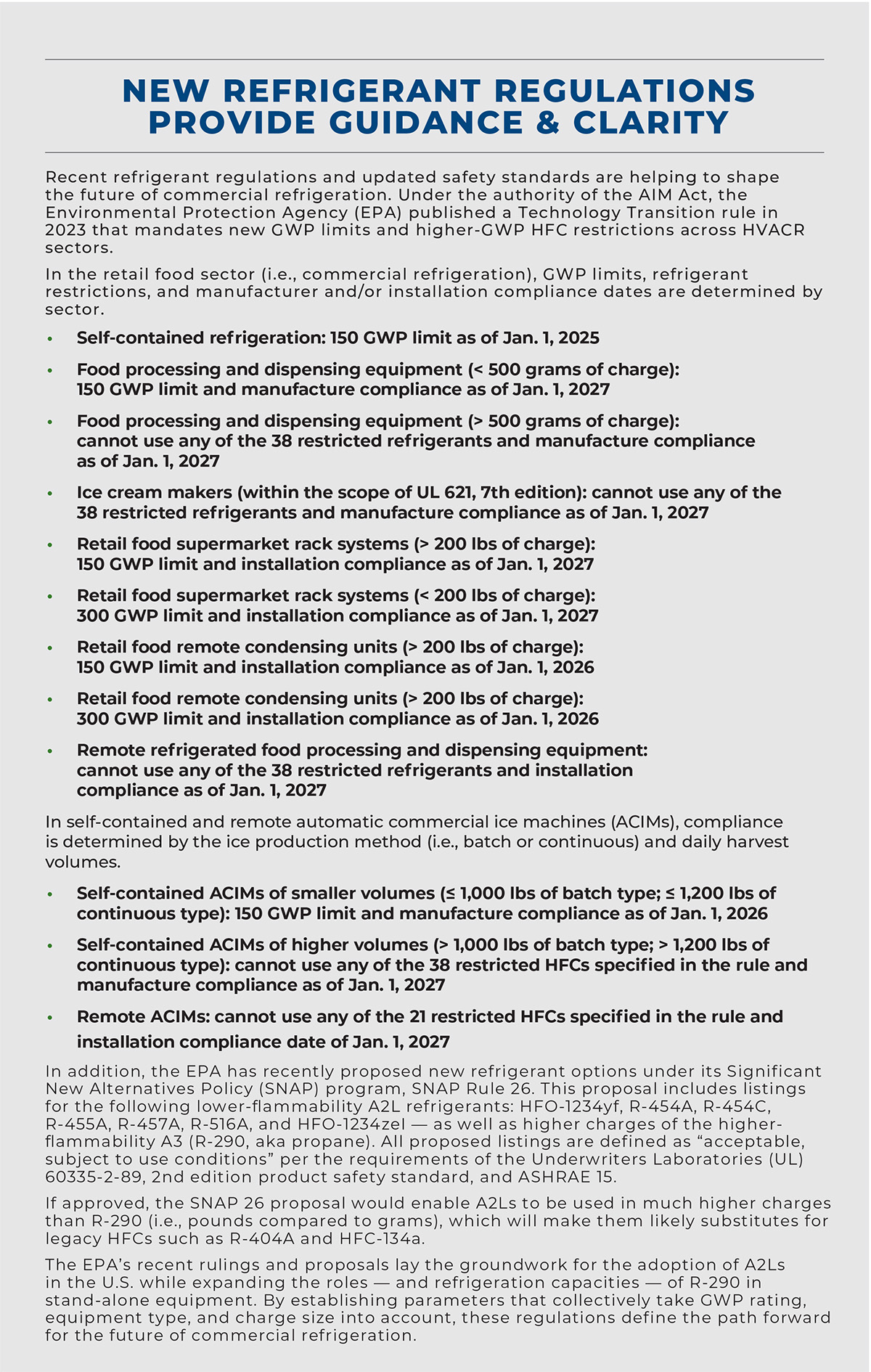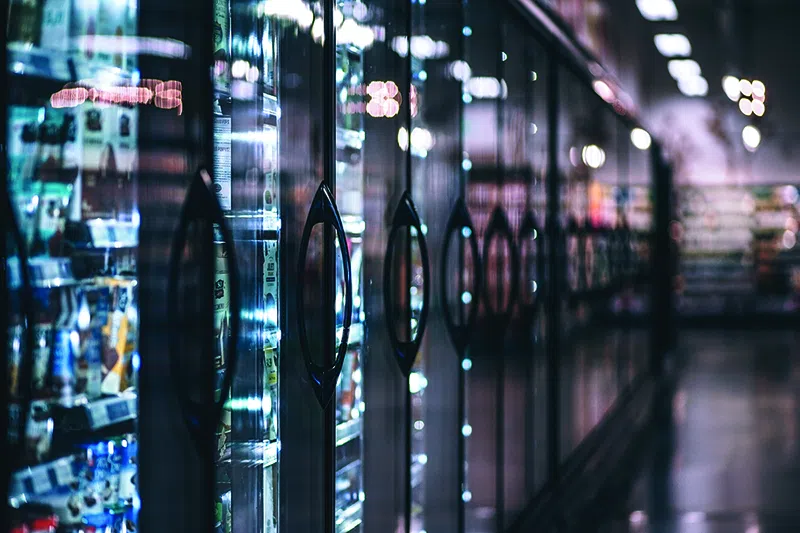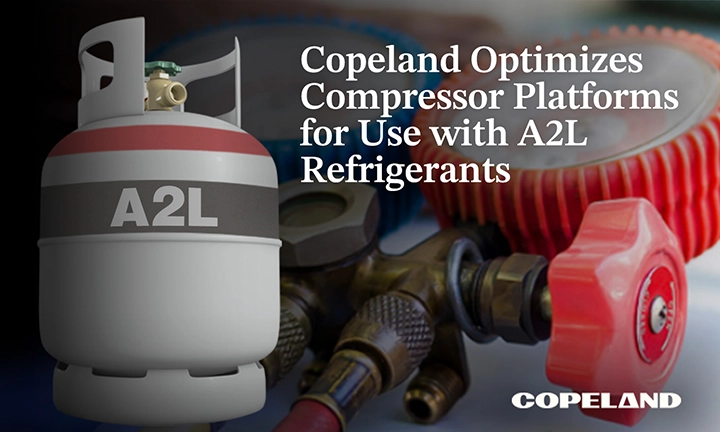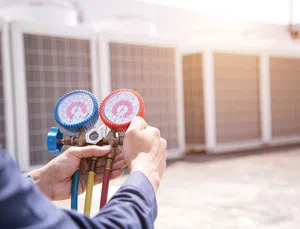After years of uncertainty about the refrigerant transition, many retail supermarket, convenience store (c-store), and restaurant operators find themselves at a historic crossroads. The passing of the American Innovation and Manufacturing Act (AIM Act) in 2020 has led to recently adopted federal regulations that authorize the hydrofluorocarbon (HFC) phasedown and mandate the use of new lower-global warming potential (GWP) substitutes.
In addition to the AIM Act, the transition to lower-GWP refrigerants is also underway within member states of the U.S. Climate Alliance. As federal regulations progress over the next several years, the HFC phasedown will impact the entire commercial refrigeration supply chain — and essentially prohibit the use of higher-GWP HFCs in new equipment. Continuous reductions in HFC supplies are expected to raise market prices for legacy refrigerants, impacting operating costs for the existing installed base of HFC equipment.
Migrating to lower-GWP refrigerants has become a critical initiative for retailers working toward sustainability goals and defining the path to net zero operations. In addition to GWP ratings, retailers must evaluate the impact of energy consumption and total greenhouse gas (GHG) emissions in their next-generation refrigerant decisions. As these efforts become top priorities, many retailers are leveraging their progress along their sustainability journeys as a competitive differentiator.
But with new refrigerant alternatives come new equipment and system architectures; questions persist about operational costs, refrigeration reliability, and application safety. Many operators are unsure about which refrigerants will be used in which equipment types, or which types of equipment will be suitable for their future store footprints.
Fortunately, the refrigerant landscape is shaping up along mostly predictable lines, as emerging lower-GWP alternatives are set to fill distinct commercial refrigeration niches. From smaller-charge, self-contained units to condensing units and remote systems to large supermarket racks, A3 (R-290), A2L (e.g., R-454A, R-454C and R-455A), and A1 CO2 (R-744) refrigerants each have their place.
Emerging Equipment and System Architectures
From small to large applications, the migration to the next generation of lower-GWP substitutes will take place along the lines of greatest compatibility per equipment or sector. Whether you’re evaluating R-744, R-290, or an emerging A2L for future refrigeration systems, each has unique characteristics, stipulations, and regulatory mandates that, to some degree, dictate their probable end uses and applications.
• R-290 in stand-alone equipment
Already listed as acceptable by previous SNAP Rules 17 and 21, R-290 has established a niche within commercial refrigeration. Today, it is widely used in commercial ice machines, water coolers, low-temperature refrigeration, and stand-alone equipment — all with a 150g charge limit.
SNAP Rule 26 has proposed increasing charge limits up to 300 and 500g, which would support expanded application and adoption of R-290 in stand-alone applications — such as closed-door and open reach-in cases found in supermarkets, restaurants, c-stores, and dollar stores.
If approved, larger R-290 charge limits would significantly raise stand-alone system capacity up to 4 horsepower (HP), thereby increasing the refrigeration potential to even include smaller walk-in units. Currently, due to the 150g charge limit, larger-capacity R-290 cases must be supported by multiple condensing units, compressors and refrigeration circuits. Increased charges would simplify this scenario by supporting more system capacity with a single compressor.
Stand-alone R-290 units may be simply air-cooled, discharging condenser heat into the retail space; multiple units can be connected to a shared, chilled water loop to remove excess case heat from the stores.
• A2Ls in stand-alone and remote systems
Compared to R-290, A2L refrigerants have the potential to play important roles within a wider range of equipment and systems, from stand-alone units to remote systems. Higher A2L charge limit allowances and relative capacities will enable their use in higher-capacity applications within the 0 to 60 HP range.
At the smaller end of the spectrum, A2Ls offer increased charge limits than R-290, enabling larger equipment capacities and refrigeration loads in stand-alone equipment — while delivering improved coefficient of performance (COP) for more efficient overall per-unit cooling capacity.
Today, remote systems — such as outdoor condensing units that support walk-in coolers, freezers, and mini racks for distributed architectures — almost exclusively use legacy HFC refrigerants. At higher charges and capacity ranges, A2Ls deliver a much-needed, low-GWP alternative in these distributed applications.
It’s important to note that A2Ls cannot be used as drop-in replacements in existing HFC systems. All new refrigeration equipment and systems must be designed and qualified to use A2Ls per applicable safety standards.
• CO2 in centralized rack systems
CO2 refrigeration has been a proven food retail solution on the global stage for more than two decades. With zero ozone depletion potential (ODP) and a GWP of 1, the environmentally friendly refrigerant has long been EPA SNAP-approved.
Early adoption of CO2 transcritical booster technology began in recent decades with few sustainably minded retailers; today, adoption is accelerating rapidly among U.S. food retailers. In the absence of a true regulatory mandate, misperceptions about its high-pressure characteristics, system complexities, and operational costs have hindered its adoption.
Today, as the total cost of ownership (TCO) for CO2 systems approaches parity with traditional HFC systems, their many sustainability benefits and potential for heat reclaim have made them more appealing to the U.S. market. The emergence of design strategies that can optimize system efficiencies per climate zone — combined with technological advancements that simplify and automate system operation — is making this a proven, viable centralized architecture for large and small retailers alike.
Copeland has led the research and development of design optimization strategies that maximize system performance and energy efficiency, regardless of climate and/or installation conditions. The E3 supervisory control for CO2 applications was designed specifically to address retailers’ operational concerns, simplify system start-up, and automate system management.
Confident Refrigeration Decisions That Align with Your Operational Goals
In our recent TCO study, the results of which will be published soon, we compare the relative costs of leading refrigerant and system options within the context of various U.S. climate zones and regional installation considerations. We’re leveraging this data to help retailers evaluate all factors contributing to system costs — including Capex (i.e., equipment costs), maintenance, and energy consumption throughout a system’s 20-year lifecycle — and determine which systems may meet their operational and sustainability goals in various store locations.
To learn more about lower-GWP refrigerants and emerging system architectures — and make more informed and confident decisions about your future equipment selections — please visit our E360 resource hub.

Reference: https://www.epa.gov/system/files/documents/2023-10/technology-transitions-final-rule-fact-sheet-2023.pdf
Andre Patenaude is responsible for supporting system-related innovation and leveraging Copeland’s global cold chain to drive adoption of integrated solutions in North America. He most recently led marketing efforts pertaining to Copeland’s food retail and chiller markets. Prior to that, he had managed Copeland’s global CO2 development. Andre has more than 35 years of industry experience in sales, marketing, training and business development of HVACR system architectures and applications with compression and component technologies. He is a certified Mechanical Engineering Technologist C.E.T. (since 1984), and is a member of AHRI, ASHRAE, and RSES.





